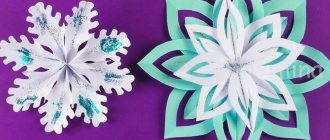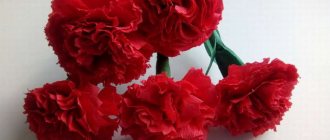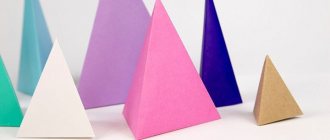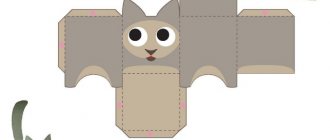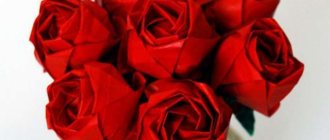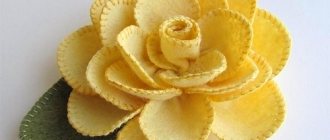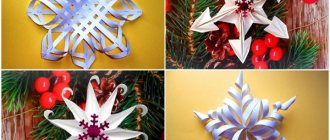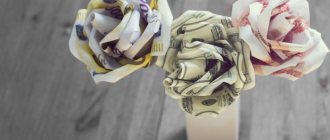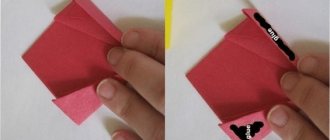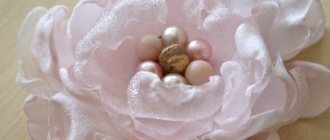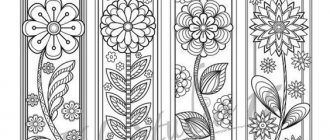Sometimes even the most insignificant detail of the interior at first glance can radically change the overall impression of it. This is completely true for the so-called art objects, often placed on the walls as additional decor. They are logically complemented by voluminous paper flowers - they are made with your own hands and displayed on the wall in order to emphasize the expressiveness of the room’s design and create a special festive mood. Various schemes and templates according to which such handmade decors are made are available in large quantities on the Internet, but how to choose the most spectacular and potentially win-win ones? We have collected all the popular options for you and offer you to immerse yourself in the attractive world of creating voluminous flowers from paper immediately. And you can find the best ideas for decorating living room walls in a modern style by following the link.
- All the pros and cons of the solution;
- What you will need to create;
- Popular options for interior;
- Even more interesting ideas;
- Useful materials: diagrams, templates, videos;
- Conclusion.
Advantages and disadvantages
It is generally accepted that artificial flowers in the interior can always be distinguished from real ones. But upon closer examination, it turns out that even professional decorators are not always capable of such a task. And here's why: by improving the floral arrangements used in the interior, their creators were able to achieve amazing success. Today, artificial flowers serve as the best decoration for living spaces and may well become a symbol of home comfort. Among their obvious advantages are the following.
- Minimal care. It is enough to remove dust regularly. Even without fertilizing, watering or regularly replacing plants in vases, the house will always be beautiful.
- No problem of departures and business trips. You can forget about drip irrigation systems or asking friends and neighbors to water.
- Minimizing the risk of developing allergies. It's simple - there is no pollen, which means there is no negative reaction to it.
- No insects. Plants in the house are an increased risk of attracting harmful parasites, which are very difficult to get rid of. In addition, during the flowering period they can be attacked by wasps, bees and hornets.
- Ease of creating aesthetic compositions in the interior. Even without understanding floristry and color combinations, you can create a beautiful composition.
- A wide range of placement options - in vases, flowerpots, flowerpots, baskets, wreaths.
- Possibility to place in any room of the house or on the street, balcony, terrace.
- Guaranteed safety for children and animals.
- The ease of changing your place of residence - transporting flowers in the ground often turns into a multi-week epic, fraught with a lot of difficulties.
But this is not without its drawbacks. The main one is the lack of aroma, but for allergy sufferers this minus can be an advantage. Burning of petals when in contact with the sun can also be attributed to the disadvantages of fresh flowers. What is definitely worth mentioning is the presence of low quality products on the market. You can buy cheap products that can fade in a humid environment, cause allergies, or fill the room with an unpleasant chemical aroma.
Ribbons
Making flowers from ribbons gives you the opportunity to fully express your creativity and imagination, and it is not at all necessary to have a high level of skill or special equipment. To make roses you will need: a satin ribbon, it is worth noting that the wider the ribbon, the larger the flower, threads, and a needle.
Do you want to know how to make artificial flowers using this technique? Read the instructions below.
Option #1:
- Cut a ribbon 0.5 meters long, fold one edge to form a triangle, twist it and hem it.
- Then the tape is assembled along its entire length in the same way, the result should be a long accordion.
- Starting from the edge, the accordion is twisted and the edges are hemmed, forming a flower.
Option #2:
- The tape is twisted into a tube in the direction away from you, forming the middle and hemmed.
- Then the ribbon is folded down, forming a petal, and continues to twist, making the same petals. The finished flower is secured at the bottom with a few additional stitches.
How flowers were made
In Europe, artificial flowers began to be created industrially at the end of the 18th century. In addition to labor-intensive and painstaking work, such work was harmful to people’s health, because the paints contained copper, arsenic, lead, and sometimes mercury. During the same period, the art of manufacturing was adopted by Poland, and then by the main trendsetter of Russia - St. Petersburg.
The tradition of decorating rooms continues today. The first artificial compositions were made of paper. The artificial flower revolution began 50 years ago in the former Soviet Union. The world saw plastic red poppies, blue forget-me-nots, and white callas. Unfortunately, their design and quality did not really impress the buyer.
Modern production technology allows you to copy an artificial flower with a natural specimen. Today, such bouquets are made from high-quality parchment, natural silk, latex, which is completely safe for human health.
Flowers are produced in different sizes and shapes ranging from erect and climbing, to small ones in pots and large outdoor ones. You can buy both single buds on legs and blooming bouquets.
Rose in 10 minutes
The second method of making a rose is simpler, it doesn’t take even 10 minutes. Prepare a long strip of red corrugated paper with a width of approximately 7-10 cm. One long edge must be processed, giving the shape of the processed edge of the pie.
Rolling a paper rose
Twisting a red rose
Pinch the edge of the strip with your thumb, proceed along the entire edge, taking into account the “overlapping” of the pinched area on top of each other.
Continue twisting
Next, the finished strip should be rolled into a bud. Carefully glue the edge to the finished bud with PVA glue or wrap the entire flower with regular thread in the color of the corrugated paper used. The resulting bud can be wrapped in green thread, creating a sepal.
Forming a rose bud
The corrugated paper rose is ready
If desired, such a bud can also be pre-planted on a special wire blank and make a whole bouquet of roses in 1.5-2 hours.
Use the presented methods to create entire rose compositions in the future. You can make a composition only from buds, gluing them onto cardboard blanks in the process of creating a number for a birthday or an ordinary picture.
DIY foamiran flowers
Foamiran is sometimes also called “plastic suede”. It consists of sheets of foam rubber of different shades, which upon tactile contact resemble the most delicate silk. To create a lily from foamiran you will need:
- sheet of cardboard;
- white and green foamiran;
- wire for the stem;
- brown felt-tip pen;
- glue;
- scissors;
- decorative stamens or beads not wired to replace them;
- iron.
First, two templates for leaves and petals are cut out of cardboard. Ready-made stamps can be purchased at a craft store. Then the template is applied to a sheet of foamiran and the required number of flower parts is cut out. On each petal, on both sides, a dark core with characteristic veins is drawn with a felt-tip pen. You can also use a pink or purple shade. Then heat the iron slightly and apply the petal to it. It will become softer and more pliable, so carefully apply a textured pattern to the surface using a toothpick. The edges are also applied to the iron so that they become wavy. The same operation is carried out with leaves. The stamens are glued to a wire wrapped in green paper, which acts as a stem. Then three petals are secured around them. It is better to use a heat gun. When the glue sets, three more petals are attached to the bud just below the first, observing a checkerboard pattern. Finish the work by gluing the leaves.
To create a poppy flower from foamiran, in addition to the main material of red and green colors, glue and wire for the stem, you will need black threads and a large bead. The principle of making petals is the same as that of a lily, only without applying veins and tint gradation. The bead, previously fixed on the stem, is wrapped in a circle of green foamiran. To keep the material in place, it is wrapped with thread three times. They form "stripes" that intersect in the center, resulting in six "snowflake" arms. To understand the technology, you need to look at the core of a real poppy. Then “pompoms” are made from threads, which are also attached to the stem around the bead. The poppy flower will now have a fluffy center. They finish the job by gluing the petals in several rows to make the bud look naturally lush.
What are flowers made of?
Corrugated paper is the most suitable for making flowers. It is better to use sheets of different colors. For the stem, use thick wire, a tube or stick, and green tape.
For the core, you can consider an original large button with rhinestones or beads and other available jewelry. Tools for holding parts together - this can be glue, a stapler, tape. This is a set for one flower.
In conclusion
Decorating with artificial flowers can be done independently, the main thing is not to rush, but to think through every action, be guided by your own taste, but listen carefully to the advice of professionals.
In general, a unique decor thought out in every detail will create a special atmosphere. Phytocompositions in the interior will give a finished look to the original artistic idea. With the help of bouquets you can create a unique design, or simply add a “zest” to the overall look. The decor can be remade many times without any problems, creating new combinations of shapes, thus updating the usual home decoration.
Flowers chosen wisely and tastefully will attract glances, and their realistic options will never let your guests doubt their naturalness.
How to make it yourself?
By creating artificial flowers with your own hands, you can create a composition that not only matches the interior of the room, but also meets your personal preferences.
What will you need?
You can make artificial flowers with your own hands from fabric or paper. For the first option you will need:
- organza;
- beads;
- needle and thread;
- scissors;
- candle and matches;
- glue;
- paper.
For the second option, in addition to paper, you will need PVA glue and polymer clay.
Procedure
To create artificial flowers from fabric, you will need to follow these steps:
- Draw blanks of petals of different sizes on paper.
- Place the blanks on the fabric and cut out the petals with scissors.
- Burn the edges of the fabric over a candle, thereby removing any protruding threads.
- Form a bud. To do this, you need to connect the petals together (small in the center, large at the edges) using thread and a needle.
- Decorate the composition with beads, securing the beads with glue.
White paper makes good artificial calla lilies. To make such a flower, you will need to cut out several hearts of the required size. Then you should roll out the polymer clay in the form of a small rope and let the material dry for 30 minutes. Next, the resulting “stamen” should be placed in the center of the heart, fold the paper and glue the edges.
Even more interesting ideas
We have collected here the most non-trivial options for volumetric paper flowers, which can be used on the wall in every home. You can easily make them yourself and hang them on the wall as decor or an art object: in most cases, they don’t even require specific diagrams and templates - such voluminous paper flowers can increasingly be seen in modern interiors, whose owners keep their finger on the pulse of the day .
Successful examples
A striking example of a laconic composition of calla lilies in a cylindrical glass vase. Artificial flowers added with water look so realistic that you can’t help but want to inhale their scent.
Delicate peonies are one of the most popular artificial flower options. Delicate colors make it possible to highlight the space of the living room or bedroom with their help. The tabletop composition looks interesting and unusual in interior design.
Tulips are an ideal choice for a modern country house or apartment. These artificial flowers really look like real ones and may well become a bright accent in a completely classic interior, they will enliven the minimalist decor of a kitchen or office.
To learn how to make a bonsai with artificial flowers, see the following video.
Tips and tricks
The rules for caring for artificial compositions depend on the material from which the flowers are made:
- plastic, porcelain or polymer clay are wiped with damp wipes that do not contain alcohol;
- soft material is cleaned with a feather duster;
- latex products are washed with a damp sponge or napkin;
- fabric products can be sent to dry cleaning;
- soft flowers are cleaned using a steam cleaner.
For home decor, it is recommended to purchase flowers made of latex or polyurethane. These materials provide maximum realism, but are expensive. To save money, you can buy artificial plants made of fabric.
Artificial flowers for the interior of different rooms: what looks best and where
Let's try to choose the most advantageous places for placing floral decorations. We remember that there cannot be many such plants, otherwise it will look more like a market than a living room. Also, you should not take large ones into a small room. Flowers should only make an accent, becoming an organic part of the room, and not play the main role here.
Hallway
Large artificial flowers are good for a spacious hallway.
Large flowers are placed either in a small group or individually. It’s best to put them in a free corner PHOTO: pinterest.ru
An important condition: greenery should not interfere with walking, especially if the hallway is already a bit crowded
Vases with flower arrangements can be placed on the floor, where they do not interfere, as well as on consoles, chests of drawers near the mirror PHOTO: dekoriko.ru
Artificial Plants for Home Living Room Interior: Color Transformation
To make your living room more lively and fill it with beauty, you don’t have to get live greenery. Even artificial plants can significantly change the appearance of a room due to their harmonious composition, vase or pot.
Large vases with voluminous bouquets can hardly fit into a small living room, but placing such decorations against a free wall of a spacious room is very possiblePHOTO: decorationinfo.ru
A bright composition on a neutral colored background will become a rich accent and a balancing element. PHOTO: decorationinfo.ru
In living rooms that do not have an abundance of accessories, you can place several flower vases PHOTO: dom-dacha-svoimi-rukami.ru
Ever-blooming plants in floor vases always make the room bright and fresh PHOTO: roomester.ru
Children's room
Breakable vases or pots are not recommended for children's rooms, so floral decorations are placed on window sills or walls.
Original, bright and very beautiful PHOTO: designmyhome.ru
Artificial greenery for bedroom decor: floral comfort
In the bedroom, it is simply blasphemous to disturb harmony, but it is imperative to promote comfort. Everyone there knows the value of a place to sleep and a sense of self. Lovers of greenery sometimes do not have enough time to care for them, or simply want to constantly see a certain flower as decoration. In this case, they are looking for unnatural greenery that meets the needs of the owner, in accordance with the style of the room.
Vases are most often located on bedside tables near the bed. Water is poured into a glass vase to fully perceive the plant as living PHOTO: kreind.ru
At the foot of the bed you can place not only banquettesPHOTO: dom-dacha-svoimi-rukami.ru
Bathroom
There is not much space in the bathroom to place flower crops. But, nevertheless, there is a place for both large and tiny compositions.
This shelf will wonderfully decorate the bathroom walls PHOTO: postroika.biz
Why not make a true magical oasis there PHOTO: tavannaya.ru
An original look at using greenery PHOTO: vannayasovety.ru
Artificial Flowers for Home Kitchen Interior
The kitchen often contains a dining room. But even without a dining area, the kitchen is beautifully decorated. Why not put a couple of pots with flower arrangements there?
You don’t have to take bright buds, but stick to spreading greenery PHOTO: roomester.ru
It is worth placing non-living plants near the working area: splashes from household chemicals will not harm them, and to restore their former appearance, the bush can be immediately rinsed under the tap PHOTO: homester.com.ua
Related article:
Types of decorative compositions from artificial flowers
Decorative artificial flowers and plants, which are beautiful in themselves, will look especially attractive in the form of specially selected compositions. By thinking through the best ways to combine colors and textures, you can get an original decoration that fits harmoniously into any interior. The most common types of flower arrangements at present are:
- Bouquets of artificial flowers. They are flowers collected in accordance with the rules of floristry, differing in color and shape. The bouquet can be used as a decorative element permanently or in preparation for a special event. To decorate your home with a beautiful bouquet of artificial flowers, you don’t have to turn to a highly paid florist. Making such a bouquet yourself does not require any special skills. To create it with your own hands, just stock up on wire cutters for cutting wire, as well as special floral wire and foam that secures the flowers. Next, it remains to decide on the flowers that will be placed in the center and along the edges of the composition, and select decorative elements to decorate the resulting bouquet.
- Plants in pots. Making a pot with a unique flower arrangement yourself is also not difficult. First of all, you need to prepare a base for attaching the stems of artificial flowers inside the pot. The material for the base can be polystyrene foam, foam rubber or floral sponge. It is convenient to attach thick stems to a cardboard or plastic circle with cut holes. Having placed the selected flowers in the pot, you can add artificial green branches to the bouquet, which will enhance the natural effect. Imitating indoor flowers, such artificial plants are practically no different in appearance from real ones. Beautiful pots will not require the time and attention of their owners and will create a feeling of comfort and coziness in the home.
- Hanging basket with flowers. In addition to its decorative function, such a basket can play the role of a candlestick or lamp. From a design point of view, it is undesirable to use hanging baskets in small spaces. Flower bouquets in a basket look best on empty walls, filling space and decorating them. A hanging basket can hold both a classic flower bouquet and a more modern arrangement. A simpler, but no less interesting option is to use an artificial climbing plant, such as ivy, in the basket. It will fit perfectly into the interior of any room in the house.
- Pots with flowers. Floor-mounted wide vases are most often used in spacious rooms and halls, trade and exhibition pavilions. Stable vessels on the floor provide an ideal opportunity to create an indoor or conservatory garden.
- Figures from flowers. Usually these are figures of animals or fairy-tale characters, which can serve as an unusual and very original gift for your loved ones.
- Compositions for the garden. The best option for decorating a garden would be a combination of natural and artificial plants and trees. As a decorative element, you can use low fences and arches entwined with hanging vines. An artificial pond will look beautiful and unusual with artificial water lilies floating on its surface.
In the photo - decorative artificial flowers, chinarostao.ru
In the photo - decorative artificial flowers, chinarostao.ru
Photo of artificial flowers, karlsbach.eu
Photo of artificial flowers, karlsbach.eu
In the photo - a composition of artificial flowers, gardencentre.ru
In the photo - a composition of artificial flowers, gardencentre.ru
In the photo - a bouquet of flowers made by hand, svadebka.ws
In the photo - a bouquet of flowers made by hand, svadebka.ws
Photo of decorative artificial flowers, rassvet-svaroga.ru
Photo of decorative artificial flowers, rassvet-svaroga.ru
2-3. Big flowers
Most craftswomen prefer to make large flowers from corrugated paper. After all, if these are artificial flowers, then you don’t have to limit yourself to natural sizes, right? In this section we will show several ways to make such flowers of unearthly beauty. And yes, when we say big, we mean this size:
Please note that there are dark pink petals in the center, and they are smaller than the light pink ones at the edges
Often, needlewomen want to make such flowers if there is a need to decorate a room, equip a wedding ceremony with interesting attributes, or simply use it for a photo shoot.
One fact worth noting is that despite the difference in size, large buds are no different in manufacturing techniques from miniature compositions.
Therefore, if you are planning to prepare an attribute for a ceremony or any celebration and have chosen flowers made of corrugated paper, then stock up on diligence and huge rulers, templates and other materials in large quantities and in impressive sizes.
Large flowers made of corrugated paper
You should also purchase several times more corrugated paper , since here you may need to make a flower of such a size that one petal can be the size of a large plate.
Among other things, I would like to say that knowing how to make flowers from corrugated paper, problems with sizes cannot arise. Moreover, most craftswomen believe that making compositions of remarkable size is even more interesting and exciting, and most importantly, much easier. All you need here is accuracy, and there will be no need to engage in fine jewelry craftsmanship.
So it is impossible to accurately answer the question of what composition sizes you should start getting acquainted with corrugated paper.
Everyone should think about the prospects for the end of the process and the characteristics of their character. But the result will undoubtedly surprise you.
Volumetric asters (video master class)
Corrugated paper makes very voluminous, lush and bright asters. These flowers are considered large in themselves, but artificial ones can be made simply fabulously large. That's what we'll do!
Final result
What's interesting about this master class is that the base is made from a simple bottle. We liked this particular option, since the result is very impressive, with its ease of manufacture and interesting choice of material. For example, a simple bottle is used as a base. See video instructions below:
Huge peony rose (video master class)
The video below shows a very beautiful giant flower. When you look at this magnificence, it seems that you cannot do this yourself. Yes, the work is painstaking, the formation of a flower from the middle to the outer petals is very interesting. But it's worth it, it turns out magical. The main thing to remember is that the quality of the paper can greatly affect the final result. It's better not to save on this. Watch the video with instructions below:
Rules of care
In order for artificial flowers to remain attractive for a long time, it is necessary to perform the following work:
- Use a feather duster or a damp cloth to periodically remove dust.
- Spray with water diluted with vinegar once a month for disinfection.
- Do not place flowers in bright sun near a windowsill or balcony, as the petals may burn out.
- It is necessary to touch the artificial stem with tenderness and thrift, otherwise the flower may crumble.
Important advice! To ensure that flower compositions have a lively and pleasant smell, aromatic products are often used. For example, you can sprinkle some lavender oil on lavender leaves. Each flower can have its own unique scent.
Not only a vase and a flowerpot can decorate a home interior. By adding a little imagination, you can create an unusual flower collage. For example, it is enough to purchase a small tabletop fountain and try to decorate it with an artificial composition.
The art invented by the ancient people is still shrouded in great mystery. After all, roses, hyacinths, camellias, like many centuries ago, are copied today in Europe. Perhaps not so luxuriously made of porcelain and gold, but natural and beautiful.
General recommendations for making large flowers
Huge flowers will look beautiful on a solid stem. The stem wire is usually wrapped with decorative ribbon in green shades.
When composing a composition of flower buds, it is advisable to maintain harmony of shades. They can have different sizes, but one shade should dominate.
You can use a screen as a home interior. Decorated with roses made of plain paper, it will indicate an individual living space. You can create the illusion of privacy.
Determining the type of composition and place for it
Compositions can be placed in a variety of places in the living room, for example, installed on coffee tables, chests of drawers, cabinets, on different shelves, mounted on doors, windows, walls, or rather large bouquets in vases can be placed directly on the floor.
Depending on where you plan to place the composition, its type will depend. There are one-sided and all-round compositions. The first ones should look equally beautiful from all sides, because... any part of them will always be in sight; such bouquets are placed on dining or coffee tables. The latter can have only one front side, the back side can be neglected and decorated with greenery; this side must be facing the wall and not attract attention when viewing this decoration.
Corrugated paper anemones
Anemones are also often used for decoration. They are incredibly beautiful and realistic.
I would like to show you another video that gives detailed instructions on how to make them. You don’t have to make decor of incredible sizes right away, start with ordinary ones in order to understand the essence of the process and get better at it, and you will also save on materials, because every small bud can then be reproduced in large sizes.
I really wanted you to get acquainted with this idea of decorating and decorating walls and other surfaces. Bookmark this article to quickly find it when you need to decorate your room for the holidays.
Compositions of artificial flowers in the interior
When decorating an apartment or house, it is very important to take into account the style of the premises. For example, if the living room or any other room is designed in luxurious Baroque, Empire or Rococo, then tall flowers would be the most suitable option
These can be roses, callas, gladioli and others
Lovers of Provencal style should pay attention to modest, laconic bouquets of lavender. And for those who prefer a minimalist interior, we recommend taking a closer look at peonies or orchids
Thematic compositions look very original. For example, a Christmas wreath or an unusual composition of flowers for Easter. Such products help create a special festive atmosphere. Therefore, be sure that they will not leave anyone indifferent. Especially if you make the composition with your own hands.
Beautiful, high-quality artificial flowers will be a wonderful decoration for any room. Depending on the interior style and personal preferences, choose the most suitable option. As a result, it will look really cool.
Artificial flowers in the interior
Vases and pots with flora look great in any apartment or house. You just need to choose the right plants.
Artificial flowers easily fit into any interior style
| Location name | How to decorate |
| Living room | Large green plants in outdoor vases and pots will help to enliven the room and give it charm. Decorate the coffee table with a small vase with a composition of bright flowers and artificial berries. |
| Bedroom | Flora in small rounded pots placed on bedside tables will add a touch of romance. |
| Hall | Don't overload the room, purchase decorative branches and place them in the corner of the room. |
| Kitchen | Conciseness is important here. Choose green plants in white ceramic pots. This will make the room look fresher and neater. Decorate your work area or table with a vase of apples, pears and peaches. |
| Corridor | Floor pots with ficus and palm trees will come in handy. |
| Balcony | Pots with climbing flowers are suitable for decoration. |
| Children's room | Buy flora from hypoallergenic materials in unbreakable pots. Give preference to bright and rich shades. |
Plants in the bedroom should please the eye and set the mood for relaxation.
Plastic flowers will add coziness to the bathroom
If your home has a staircase, then you can decorate it too. Hang flower garlands on the railings, and place several small vases with flora on the steps. To decorate the bathroom, it makes sense to use artificial flowers that are not afraid of moisture. Compositions made of latex and plastic are an ideal option.
It can be difficult to allocate space for a vase or pot; in this case, a floral arrangement in the form of a panel will help out
In addition, flowers can be used to decorate a floor lamp shade in any room, decorate a wall with a panel of beautiful plants, place a Hawaiian garland on the head of a bed, or decorate a fireplace with it. There are a lot of decor options - everything is limited only by your imagination.
Tips for choosing material
Modern factories offer the following materials for making flowers:
- Textile;
- Latex coated fabric;
- Foamed polyurethane;
- Latex.
Fabric products are the most common, their price is quite reasonable and accessible to everyone. Outwardly, they may be highly similar to their living counterparts, but are still significantly inferior in this indicator to non-woven polymer competitors. To make textiles more realistic, they are sometimes coated with latex, which naturally increases the price.
Products made of latex and polyurethane can boast a high class of realism; they are called “real touch” colors, visually and tactilely imitating natural qualities. They are not afraid of humidity, they can be washed in water, and therefore they are the only ones suitable for decorating the kitchen and bathroom. The only negative is the relatively high cost.
Material
The materials most often used for the flower itself are paper (chalk, corrugated and other varieties), fabric, thin plastic and foamiran (foamy decorative material). In additional work (creating the stem and leaves), you can use wire, iron and wooden rods or plastic.
As a rule, the chosen material determines the technique used to create the buds. Decorations made of plastic and fabric require the greatest expenditure of materials and time. Having chosen them, you will need not only to stock up on an impressive list of tools, but also to have considerable experience in processing capricious raw materials.
In the case of paper or foamiran, such problems do not arise. Schemes for making large flowers can be easily found on the Internet, and to create a masterpiece, you just need to strictly follow the instructions.
Artificial flowers
For those who love flowers very much, but cannot use live plants in the decor of their home due to allergies or the inability to regularly care for their “green pets,” we can offer an alternative in the form of artificial flowers. Of course, we are not talking here about banal rag or plastic products, but about high-tech and attractive items, which are presented in a wide range on the market of modern interior design items.
Modern technologies, which bring new miracles into our lives every day, have in the last few years turned the production of artificial plants and flowers into a fashionable decor trend for decorating a wide variety of premises: from office offices to our apartments.
The latest polymers and materials from which artificial flowers are made make them almost indistinguishable from natural ones. Natural colors and texture, high-quality elaboration of even the smallest details make artificial flora so close to real vegetation that sometimes the difference can only be detected from a very short distance. Trembling sunflowers and irises, peonies and hydrangeas made of natural silk, elegant roses and chrysanthemums made of cold porcelain look so natural that sometimes you marvel at the art of modern masters.
Using artificial flora, creating an exotic room design is much easier than using natural living material. Such an exhibition is easy to update; it will not wither if you have to leave for a long time or if you are sorely lacking free time to care for fresh flowers. Such artificial phytodesign is much easier to combine with the surrounding environment, since it will remain unchanged, regardless of the time of year and the amount of sunlight in the room.
How to make a flower pattern
The page below will provide diagrams and ready-made patterns for petals of various colors, but for those who want to learn the ancient craft from scratch, a little theory.
The main element of an artificial flower is its petals. The quality of the finished product will depend on the accuracy of its shape and texture. It is recommended to “cut out” very small petals using special forms: the fabric is folded 6 or 8 times, wrapped in paper and placed on a small metal platform. The form is held level and hit with a hammer, obtaining petals ready for further work.
Large petals can be cut with scissors. The best patterns are those for which real, fresh flowers serve as models. To do this, the plant is disassembled into its component parts, the petals are carefully straightened and dried either under a press between two sheets of thick absorbent paper (coffee filters can be used), or, best of all, according to all the rules for making a classic herbarium
.
Then all the dried parts of the flower are carefully laid out on a sheet of paper, traced along the outline with a pencil, then the sheet is glued onto cardboard and only after that each part is cut out separately. Don’t forget to label each pattern with the name of the flower and petal number.
As for leaves, stamens, buds and other parts of plants, the author of the book, who is concerned about saving the flower girl’s time, recommends that she buy ready-made preparations. But at the same time he makes a reservation that if the craftswoman has free time, patience and taste, then, of course, it is best if all these details are made by hand.
Features of choice for various rooms
The purpose of the room plays an important role when choosing the interior and furnishings. Therefore, when buying artificial flowers, you need to immediately decide for which rooms such products are intended. In addition, it is necessary to take into account the features of the interior (in particular, the color scheme) and select the appropriate “plants”.
Kitchen
Decorative fruits, vegetables or berries are suitable for the kitchen interior. Bundles that imitate spices are usually placed above the stove (or nearby): garlic, onions, peppers. Artificial compositions in the kitchen interior are placed in compact vases on tables or window sills. The best choice is considered to be decorative orchids or roses.
Hallway
It is this part of the house that is best suited for decorating with artificial “flora”. There is not enough light in the hallway to grow natural plants.
Curly “flowers” are suitable for the hallway, which can be hung on the wall or placed between the furniture. The latter option looks good in compact spaces.
Living room
The living room, like the kitchen, is a place where residents and guests often gather. Therefore, choosing colors for a given room can be difficult. In this case, it is recommended to take into account personal preferences and the size of the room. You should also take into account the features of the interior and select flowers so that they do not stand out from the background, but complement the overall design.
In large living rooms, large plants look good, including palm trees or flowers in tall vases. In such rooms you can also place several compositions of decorative “plantings”. In small living rooms, it is recommended to place flowers in compact vases or pots.
Bedroom
Decorative plants are usually not purchased for the bedroom. This is explained by the fact that such products attract dust, which causes people’s breathing to worsen over time. Therefore, it is recommended to place natural plants in the bedroom.
Bathroom
The bathroom constantly maintains a high level of humidity. Taking into account this circumstance, decor made of clay or plastic is usually placed in this room. Depending on the area, you can install compact flowers, climbing plants or a large vase with artificial “flora” in the bathroom.
Children's room
Natural plants are also predominantly placed in the children's room. Among artificial ones, it is recommended to give preference to those made of hypoallergenic material.
Popular options for interior
Trying to select the most beautiful and interesting three-dimensional flowers from paper for the wall, made with your own hands, is like standing in a flowering meadow and meticulously examining each opened flower: existing templates and diagrams allow you to achieve a result that is magnificent in every sense. If, of course, you follow the established recommendations. Of course, people who have already thoroughly gotten their hands on creating such decors from flowers can, with a clear conscience, begin to develop exclusive wall decorations, made in strict accordance with their original plans. Everyone else should first learn from already known models, so that later they can join more skilled comrades. Creating three-dimensional flowers from paper for walls using diagrams and templates has one enormous advantage - you already know what the result should be. This allows you to determine in advance whether this or that application
into the format of your room or not, and not waste time creating a deliberately unsuccessful decor.
We offer you several options that have a good chance of settling on the wall of your home. With detailed instructions, diagrams, example templates - so that you know exactly what you are doing and how you are doing it and have full control over the entire grueling, but such a pleasant creative process. We also present to your attention 4 ways to properly decorate walls in a kindergarten.
Roses
Such a decorative solution for the wall will always find its application. Roses create a special gentle mood and add shades of freshness and tranquility to the atmosphere. It seems that such a voluminous paper flower hung on the wall in the bedroom will become one of the remarkable features of the interior. Here are sequential instructions for your attention:
- take a pink sheet from a regular set of colored paper;
- draw a spiral on it;
- we cut out the spiral with scissors, you can take a figured version of them - the craft will be more attractive;
- we wrap the ends of the spiral outward and twist it to the end, gradually loosening the tension;
- fix the resulting fragment with glue;
- bend the circle in the center of the rose, drip glue onto it and glue the bud.
What does it look like
Another example with roses
- take corrugated paper;
- prepare petals from it;
- give them an oval shape;
- Using scissors, make small teeth at the end of the petals;
- twist each petal onto a pencil and leave it like that for a few minutes;
- Next, you should remove the pencil, but do not open the petal;
- the inner petals, which are tightly pressed to the stem, are attached with glue;
- then the remaining petals bend outward and are attached to the stem.
According to your desire, you can bend them strongly, or barely. Depending on this, the voluminous flower will turn out to be more or less open.
What does it look like
A small selection of homemade roses
Video for making roses with your own hands
Tulips
A classic three-dimensional wall decoration that can be made by a person who has never been interested in handmade before.
Asters and chrysanthemums from old magazines
It turns out that sometimes old color magazines can be useful even several years after their publication. They are perfect for making voluminous flowers - you can place them on the wall and enjoy a magnificent, spectacular look.
- select old pages from magazines with the most dynamic color dynamics;
- Fold each one 4 times along its length and cut with fringe from the fold side;
- Please note that you do not need to cut about 1 centimeter to the edge;
- wrap the resulting fringed ribbon around the top of the skewer and glue it;
- to make the bud larger and more beautiful, you need to wrap the skewer with ribbon several times, and then glue the free part of the fringe;
- the final stage is to cover the entire skewer with adhesive tape and glue the cut out plant petals.
Fairy lights
A very effective version of volumetric flowers made of paper, which will fit on the wall in any interior. Especially during some holiday. The main advantage is the amazing simplicity of execution. Well, see for yourself how everything is available:
- from any corrugated paper, preferably with a brighter and lighter tone, cut into rectangles, fold them into piles of 5 pieces;
- if you want the garland to shimmer with gradients, make a mix in each stack of the corresponding tones;
- collect each stack into an accordion;
- fasten in the center with a stapler, and round the edges so that you can mistake them for petals;
- straighten the resulting accordions - do it in different directions;
- get very simple but incredibly attractive buds;
- All that remains is to string them on a fishing line - and you will get a ready-made flower garland.
Floral decorations with hearts
The imitation of the stem allows us to classify this handmade as a floral one. Otherwise, this is pure creativity, born of the desire to create a sensual mood in the interior and emphasize the tenderness of its owner’s heart with the help of voluminous paper flowers on the wall.
Lily
Such voluminous paper flowers can be hung on the wall or placed on a shelf in almost any room - according to the diagram below, you can make an applique with your own hands and surprise yourself and your loved ones with unexpectedly straight hands. A voluminous paper flower on the wall will look especially relevant in the spring - with the arrival of the first warm days.
Design design
In order for the decor with artificial flowers to be of high quality and complete, you need to start with a project. All the subtleties of the future design are displayed on paper
It is important to think over the general idea, style, color palette, composition, and you need to take into account the budget
If you don’t want to hire a decorator to implement the design, then you can at least instruct him to draw up a detailed plan with sketches and descriptions; this option will be more successful, because Such design requires special skills and extensive experience in floristry
If it is important to get the maximum result, then you need to leave this work to a specialist
Professional phytodesigners will create beautiful compositions that suit your home. In cases where it is not possible to hire a designer, you can realize your creative ideas yourself. To get a decent result, follow the advice from this article.
Caring for artificial flowers
Autumn bouquet of artificial flowers
The floral arrangement must be kept clean. For this:
- use a feather whisk (ideal for fabric flowers);
- wipe the petals with a damp cloth (for plants with a smooth texture: for example, made of polymer clay, cold porcelain or plastic);
- spray with water and vinegar diluted in equal parts (this method perfectly deodorizes and disinfects artificial flowers);
From time to time, do not forget to wipe the flowers from dust or simply spray them
- fabric plants can be dry cleaned;
- You can also use a steam cleaner.
What to look for before buying artificial flowers?
The bedroom is a very important place where flowers must be placed.
- Smell them. Flowers should not have an unpleasant “plastic” smell.
- Check with the seller what materials the decor is made of and whether they are harmless.
- If you are allergic to dust, choose flowers with a smooth texture. In this case, less dust will accumulate on them.
You can pour water into a vase with artificial flowers to make them look more vibrant and natural.
Potted crops
Indoor flowers require a scrupulous attitude, but unfortunately, not everyone has the necessary knowledge and skills that help maintain their decorative quality. Plus, potted plants are very picky about many indicators, such as temperature, light, humidity, and require regular replanting, and in some cases special growth restrictions. Sometimes you really want to decorate an empty corner with a green bush in a beautiful flowerpot, but it is likely that due to lack of light it will quickly lose its attractive appearance or even die.
There is a way out of this situation; there are artificial flowers that replace popular indoor plants: anthurium, ficus, azalea, dracaena, dieffenbachia and others. You can not be afraid to leave such decor for a long time unattended; the only care they require is periodic dusting or washing in the shower.
LiveInternetLiveInternet
Quote from message klassika
Read in full In your quotation book or community!
Making flowers and fruits from silicone
Master class taught by Elena Samsonova
I offer you a master class on making beads from acetic construction silicone (acid silicone sealant). When purchasing sealants, keep in mind that in addition to silicone sealants, they also sell others (urethane, acrylic, etc.), the properties of which are not discussed in this article. So, if you bought transparent silicone sealant at a hardware or hardware store (you can also buy white and also tint it, or blue, red or black, to which you don’t have to add dye), opened it and smelled vinegar - you bought exactly the one which we will talk about below.
Acetic silicone sealants are considered purified and therefore are used in areas with increased sanitary requirements. They are used to seal seams in ovens, refrigerators and other places that come into contact with food. These sealants are environmentally friendly and safe for human health, you can work with them without special protective equipment, not forgetting only about good ventilation, since caustic acetic acid in high concentrations can irritate sensitive skin and mucous membranes. The only safer products than vinegar sealants are specially formulated sealants for aquariums. Aquarium silicone is absolutely harmless to living organisms. But it does not become this way immediately, but 7-14 days after application, i.e., when the vulcanization reaction is completely completed. So it’s worth looking for sealant not only in hardware and construction stores, but also going to a pet store. Avoid using silicone with antifungal components - it is intended only for sealing joints in toilets and bathrooms; contact of such silicone with food should absolutely not be allowed.
After hardening, silicone retains rubber-like elasticity and plasticity. Therefore, you should not paint and/or varnish silicone products - it will peel off anyway. If desired, paint (food coloring is best) or ink can be mixed with the silicone that has not yet hardened immediately after opening the container, and work with the already colored one. When adding a dye, keep in mind that it can change the properties of the silicone and slow down or speed up the hardening process. Add paint literally drop by drop - for 50-80 ml of silicone, about half a teaspoon of dye is more than enough, or better yet, even less. Water-based paints speed up the vulcanization process of silicone - if you tint silicone with such paints, after 5-10 minutes it will be almost impossible to squeeze it out. Hardened silicone has increased moisture resistance, can withstand both low and high temperatures (from −50C to +200C), and is insoluble in most acids and alkalis.
To make silicone beads you will need:
1. Silicone (50-80 ml for one “sitting”), transparent, white or any other color you need.
2. Dye (ink from ballpoint or gel pens, non-water-based paints, food coloring, etc.), if you decide to tint the silicone.
3. Toothpicks, wooden skewers or sticks.
4. Gloves (not latex). You can do without gloves - just try not to get dirty and dry your hands often.
5. Toilet paper or napkins (lots of them).
6. Small plastic bags, or a syringe, or disposable plastic cooking bags.
7. Scissors.
8. Disposable syringe. The ideal option is culinary attachments of the smallest sizes, with a simple round hole (No. 2, No. 3), a hole for leaves (No. 65s, No. 65) if desired, and a third one for petals (No. 101, No. 102). But you can do without attachments: you just need to make a small slit in the bag and squeeze through it, or use disposable syringes or homemade attachments made of plastic or pen caps. If you get a whole set of such attachments, then you can do anything with silicone.
9. Wax paper, newspaper or cellophane to protect the work surface.
Silicone “production” is quite easily soiled - stock up on napkins and wipe your hands and everything else on them more often. Before washing with soap and water, both hands and tools must be thoroughly dried, getting rid of all silicone if possible (remember: silicone hardens precisely from moisture).
After hardening, silicone easily comes off plastic and polyethylene. But metal and glass can be a little tricky to clean. If you don’t mind, stock up on a special solvent for your sealant, then cleaning the tools will be very easy. They say that white spirit also helps a lot, but I usually just need paper napkins.
So, you squeezed transparent or white silicone out of a tube into a palette (glass ashtray, disposable cup, etc.), mixed it with a wooden (ice cream) or plastic (lollipop) stick with a drop of paint or ink.
Then we place the colored paste in a syringe, in a prepared bag with a nozzle, a bag for silicone, or simply in a bag with a small hole cut in the corner - the size and shape of the squeezed out silicone drops will depend on the size and shape of the hole. The photo shows the bag I use. Since it is not cone-shaped (you can use a disposable culinary bag - then everything is very simple), I had to wrap the junction with the nozzle with electrical tape so that the silicone did not flow over the edges, but went straight into the nozzle. If you use a syringe or a cooking bag, this problem will not arise. And this is not a problem at all if there is electrical tape or adhesive tape in the house.
We put a bead (glass, wood or plastic) on a toothpick and begin to carefully squeeze the silicone from the bag onto it. Base beads for working with siliconeThe shape of the base bead will also depend on the shape of the silicone bead. You can use round, oval, cone-shaped, elongated and any other beads to achieve the desired result.
It is better to squeeze roses and Christmas trees onto cone-shaped or elongated beads.
Raspberries and blackberries work well on round, oval and cone-shaped ones. Corn is best done on a long stem. Pineapple - on the oval. Any other images and flowers may require a base of any shape - the limits are limited only by your imagination. Interesting effects can be achieved with undyed transparent silicone by applying it to multi-colored beads or beads with glitter.
Keep in mind that the working time of silicone is about 30 minutes. It depends on the temperature and humidity, as well as on the dye used. In humid and warm air, silicone can harden as early as 5 minutes. It’s very good if you can choose a dye that allows you to work with silicone for a longer time.
For example, having realized that one dye (water-based) made my silicone harden literally after the third bead, I began to add another type of ink (alcohol-based) to it, which prevents the silicone from hardening so quickly. The result is a mixture that I can easily work with for 30-40 minutes and manage to make about 10 beads during this time. Experiment! And find the best color and time option.
Keep in mind that too much paint can negatively affect the silicone's formula and prevent it from curing at all. Normally, silicone hardens within 24 hours so that it can be touched without disturbing the shape of the bead. If on the third day your beads remain too soft and sticky, it means that the dye was chosen poorly - try another one.
The process of making blackberry beads from silicone.
To squeeze out round beads, squeeze the silicone through the round hole, holding the tip at a 45-degree angle to the surface of the base bead. Squeeze a little silicone onto the bead so that a droplet falls with its flat cut onto the surface of the bead in the right place (start dripping from the top hole). Continue applying even pressure on the syringe or bag until a round droplet of the desired size is formed. Then stop pressing and sharply move the tip down, smearing the remaining silicone on the base bead (as if wiping it on the bead). Repeat this movement until the desired effect is achieved. For raspberries and blackberries, you will need to cover the entire bead with droplets, placing them in a circle, close to each other in a checkerboard pattern.
Needles are also made using a round or slightly oval hole. Silicone beads with needles Point the tip at the base at a right angle. Squeeze out the required amount of paste, stop squeezing and lift the tip sharply upward at the same right angle - the silicone will come off the tip, leaving a mark in the form of a needle tail. Place the next drop close to the previous one. Fill the entire surface of the bead.
It is convenient to adjust the length and direction of the “spines” and clean up various irregularities with the tip of a toothpick.
It is best to squeeze roses out of a flat or slightly curved narrow hole. The process of making rose beads from silicone If there is no special nozzle (No. 101 or No. 102), try making one from a pen cap, for example, or molding it from plastic, making the desired slot with a blade or a sharp thin knife. For the base, fashion it out of plastic or choose a cone-shaped bead. Squeeze the petals one at a time in a circle, starting from the top. Direct the tip at an angle to the bead (slightly away from it), gradually increasing the angle of inclination.
At the same time as squeezing out the paste, turn the bead on the toothpick so that the petals lie in a spiral.
You can come up with any other flowers yourself - dandelions, chrysanthemums, various buds. You just need to change the shape of the nozzle, as well as the angle, direction and intensity of squeezing out the silicone. It is convenient to correct and clean up irregularities with the tip of a toothpick.
It is convenient to attach leaves to flowers and berries after the beads have completely hardened. Adding leaves to silicone beads Then you can remove the finished berry from the toothpick (if it is a little stuck, you can trim the silicone with nail scissors or half a razor blade), turn it upside down on the side where the sepal should begin and calmly squeeze out the leaves, masking the remaining irregularities with them if necessary.
In the absence of a special culinary attachment (No. 65 or No. 65s), the leaves are made with the same round or oval hole as the needles. You just need to guide your hand when tearing it off at the angle required by the leaves, not necessarily 90 degrees. If you have a nozzle, practice squeezing leaves of the desired size and shape with it. The different force and duration of pressure on the syringe or bag will determine the shape of the leaf (its width, length, location).
The surface of silicone products is rubbery to the touch, and various fibers and threads, especially woolen hairs, easily stick to it. Therefore, I would not recommend using silicone for jewelry, especially winter jewelry. A bracelet, earrings, beads will collect all the fibers from your favorite sweater, scarf, or blouse. In summer, wearing such products will be less problematic. Miniature silicone beads in the shape of flowers and berries (by the way, who else has ideas of what can be squeezed out? Hedgehogs, frogs, spider bugs? They can serve as excellent accessories for your dolls, decorative elements, decoration of jars for dried fruits, saucers for jam ( see above - acetic silicone is absolutely harmless a week after application). Such beads are not afraid of either cold or heat, they are not afraid of alcohol, soap and other cleaners. They can be washed, frozen and put in the oven.
Silicone can withstand heating up to 200C if no paint is added. Please note that if a dye has been added, the heat-resistant properties of the silicone may change. Red sealant, industrially manufactured specifically for high temperatures, can withstand temperatures up to 400C. But if, for example, you mix acrylic paints into transparent silicone, then in the oven already at 100 degrees anything can happen to the silicone due to an increase in the percentage of water and acrylic in it, so it’s probably better not to experiment with the oven.
Silicone beads can be stretched in any direction - they are elastic. They can be dropped (if the glass bead inside does not break, the silicone will have no harm). But they are very easy to cut and pierce with sharp objects. Mentioned above is the common use of silicone glue to add volume to decoupage elements. So you can safely include silicone beads in projects using the decoupage technique or, for example, glass painting (considering only that the silicone itself should not be coated with varnish and paint - it will crack).
Have you already realized what limitless spaces for imagination this material opens up? So go and create!
source - https://md-zadina.ru/
